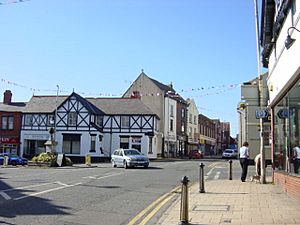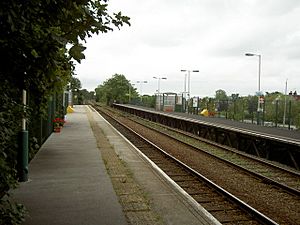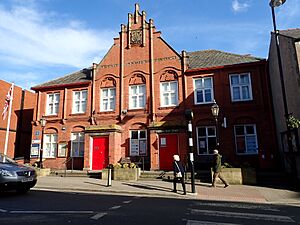Neston facts for kids
Quick facts for kids Neston |
|
|---|---|
 The Cross, Neston Town Centre |
|
| Population | 15,221 (Built-up area) (2011 census) |
| OS grid reference | SJ285775 |
| • London | 175 mi (282 km) SE |
| Civil parish |
|
| Unitary authority |
|
| Ceremonial county | |
| Region | |
| Country | England |
| Sovereign state | United Kingdom |
| Post town | NESTON |
| Postcode district | CH64 |
| Dialling code | 0151 |
| Police | Cheshire |
| Fire | Cheshire |
| Ambulance | North West |
| EU Parliament | North West England |
| UK Parliament |
|
Neston is a lively market town and civil parish in Cheshire, England. It's located on the Wirral Peninsula, which is part of the Cheshire West and Chester area. The town and its nearby areas include places like Parkgate, Little Neston, Ness, Burton, Puddington, and Willaston.
In 2011, the Neston area had a population of about 15,221 people. It's a place with a rich history and a strong community feel.
Contents
A Look Back in Time: Neston's History
Neston's name comes from the Viking language, Old Norse. Nes-tún means 'farm or settlement near a headland'. You can even find another town called Nesttun near Bergen in Norway!
Neston was first mentioned in the Domesday Book in 1086. This was a huge survey ordered by William the Conqueror to record everything in England. Back then, Neston was called Nestone and had about eight households.
How Neston Grew: Civic History
Neston became an official market town in 1728, thanks to a special permission called a royal charter. This meant it was an important place for trade and business.
Long ago, Neston was known as Great Neston to tell it apart from the smaller nearby village of Little Neston. Before the town of Birkenhead grew big in the 1820s, Great Neston was the largest village in the Wirral area. Over time, Great Neston and Little Neston joined together. From 1894 to 1974, Neston had its own local government. Today, it's part of Cheshire West and Chester.
Neston as a Port Town
Neston used to be a very important port where ships would load and unload goods. This was before the River Dee became too shallow with silt (mud and sand). When the river became harder to use, the port moved to nearby Parkgate. Eventually, most of the ship traffic moved to Liverpool in the early 1800s.
Neston's Mining Past
Neston also has a history as a mining village. There were two main times when coal was dug up from under the ground here.
The first period was from 1759 to 1855, at Ness Colliery. This mine was special because it used underground canals! Boats would carry the coal deep inside the mine. However, it closed in 1855 because many of the coal seams (layers of coal) were used up, and it was hard to move the coal around.
The second mining period began in 1875 with Neston Colliery, which later became Wirral Colliery. By this time, the Chester and Birkenhead Railway had a line to nearby Parkgate. A special branch line was built to the colliery, making it much easier to transport large amounts of coal. The mine was even taken over by the British government during World War I. But after the war, it faced tough competition from bigger mines and closed in 1927, meaning 180 people lost their jobs.
Where is Neston? Geography
Neston is located at the southern end of the Wirral Peninsula. It sits right on the eastern bank of the Dee Estuary, which is where the River Dee meets the sea.
 |
Parkgate | Gayton | Raby Thornton Hough |
 |
| Greenfield (across Dee Estuary) |
Willaston | |||
| Flint (across Dee Estuary) |
Little Neston |
Getting Around: Transport in Neston
The A540 road connects Neston to towns like Heswall and West Kirby to the north. It also links to Cheshire, Chester, and North Wales to the south. Neston is also close to the M53 and M56 motorways, which makes it easy to get to bigger cities like Liverpool and Manchester.
Neston railway station is on the Borderlands Line. You can catch trains south to Flintshire and Wrexham, or north to Bidston. From Bidston, you can connect to the Merseyrail network, which takes you to places like Liverpool.
Life in Neston: Community and Attractions
Neston is known as a great place to live. It has many unique shops, cafes, and bars. You can also easily walk to nearby Parkgate, enjoy countryside walks, or explore the Wirral Way.
Places to Visit
One of the most popular attractions near Neston is Ness Botanic Gardens. These beautiful gardens opened in 1898 and are looked after by the University of Liverpool. They are a wonderful place to explore different plants and flowers.
Local Events
Neston hosts a weekly market every Friday. Here, you can find fresh local produce like fruits, vegetables, meat, fish, cheese, and baked goods.
A very special event in Neston is Ladies Club Day, also known as Ladies Club. This unique marching day happens every year on the first Thursday of June. It has a long history, linked to the Neston Female Friendly Society from the time of the Napoleonic War.
Education
For secondary school students, Neston High School serves the local area.
Town Improvements
From 2006, Neston worked on a project called the Neston Market Initiative (NMTI). The goal was to attract more visitors and boost the town's economy. This project helped improve the look of the town centre, including new shop fronts. A new Sainsbury's supermarket was also built, opening in December 2010.
Sports in Neston
Neston has a strong sports scene. The Neston Club in Parkgate is home to Neston Cricket Club, which plays in a top league. Neston Hockey Club is also based there. Club members can use the clubhouse, tennis courts, bowls, squash courts, and take fitness classes.
Neston Nomads Football Club, started in 1983, plays its home games near Neston High School. The first team currently plays in the West Cheshire 3rd Division.
News and Media
Local news and TV shows for Neston come from BBC North West and ITV Granada. Because Neston is close to North Wales, you can also sometimes receive signals from BBC Wales and ITV Cymru Wales.
For radio, you can listen to stations like BBC Radio Merseyside, Capital North West & Wales, Heart North West, Smooth Radio North West, and Dee Radio.
The town is also served by local newspapers like the Wirral News and the Chester and District Standard.
How Neston is Governed
Neston is part of the Chester North & Neston area for national government. The current Member of Parliament (MP) is Samantha Dixon, who represents the Labour party. An MP is a person elected to represent their local area in the UK Parliament.
For local government, Neston is part of the Cheshire West and Chester council. This council looks after local services like schools, roads, and libraries. Neston also has its own elected town council, which meets at Neston Town Hall. This council represents the people of Neston, Little Neston, and Parkgate.
Who Lives in Neston? Demographics
Here's a quick look at the different ethnic groups living in Neston:
| Ethnic group | Percentage |
|---|---|
| White British | 98.5% |
| White Irish | 0.1% |
| White Other | 0.5% |
| Mixed | 0.2% |
| Asian | 0.1% |
| Black | 0.1% |
| Chinese | 0.3% |
| Other | 0.2% |
Beliefs in Neston: Religion
Here's a look at the different religions people follow in Neston:
| Religion | Percentage |
|---|---|
| Christianity | 82.6% |
| No religion | 10.7% |
| None specified | 6.1% |
| Muslim | 0.2% |
| Jewish | 0.1% |
| Buddhism | 0.2% |
| Sikh | 0.1% |
| Other | 0.1% |
Famous People from Neston
Neston has been home to several notable individuals:
- Thomas Wilson (1663–1755) was a Bishop of Sodor and Man for many years.
- Emma, Lady Hamilton (1765–1815) was a famous English model and actress. She was known for being the mistress of Lord Nelson and a muse for the artist George Romney.
- Sir Wilfred Grenfell (1865–1940) was a medical missionary who worked in Newfoundland.
- Lieutenant Colonel Christopher Bushell (1888–1918) and Billy Congreve (1891–1916) were both English soldiers who received the Victoria Cross, a very high award for bravery.
- George Ward Gunn (1912–1941) was another English soldier who received the Victoria Cross.
- Ralph Millington (1930–1999) was an English footballer who played many games for Tranmere Rovers F.C..
- Sir Tim Hunt (born 1943) is a British biochemist who won the Nobel Prize in Physiology or Medicine in 2001 for his discoveries about protein molecules.
- Patrick Wormald (1947–2004) was a British historian and academic.
See also
 In Spanish: Neston para niños
In Spanish: Neston para niños




